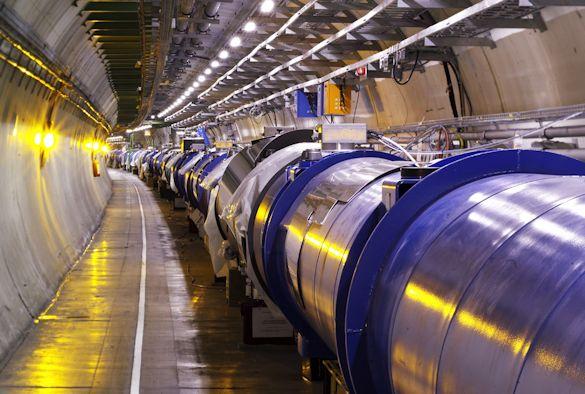![]() HL-LHC project stimulates new collaboration
HL-LHC project stimulates new collaboration
by Carsten Welsch (University of Liverpool)

View from the LHC tunnel (Credit: CERN)
A new multi-million-pound project between CERN, the Science and Technology Facilities Council (STFC) and six other UK institutions has been launched to contribute to the upgrade of the Large Hadron Collider (LHC) at CERN in Geneva. The world’s highest energy particle collider shall be upgraded to the High Luminosity LHC (HL-LHC) in the 2020s through international collaboration.
The challenges of this project are best tackled with input from the project partners from around the world. Several partnerships have already been established with the HL-LHC project and there is room for more potential partnerships in the future. It has now been announced that the UK will make contributions in four areas across the new HL-LHC-UK project among other contributions from UK universities1.
The full exploitation of the LHC is the highest priority in the European Strategy for Particle Physics, adopted by the CERN Council and integrated into the ESFRI Roadmap. The full HL-LHC project funding was approved by the CERN Council in June 2016. To extend its discovery potential, the LHC will need a major upgrade around 2025 to increase its luminosity (rate of collisions) by a factor of 10 beyond the original design value (from 300 to 3,000 fb-1). This will enable scientists to look for new, very rare fundamental particles, and to measure known particles such as the Higgs boson with unprecedented accuracy.
Upgrading the LHC calls for technology breakthroughs in areas already under study, and requires about 10 years of research to implement. HL-LHC relies on a number of key innovative technologies, representing exceptional technological challenges. Led by experts from the Cockcroft Institute, the HL-LHC-UK project has now been established to address these challenges.
Within HL-LHC-UK, the partner institutions will perform cutting-edge research and deliver hardware for the LHC upgrade in four areas: 1) proton beam collimation to remove stray halo protons, 2) the development and test of transverse deflecting cavities (“crab cavities”), 3) new methods to diagnose the stored beams including gas jet-based beam profile monitors and, 4) novel beam position monitors, as well as sophisticated cold powering technology needed for the cryogenic systems.
Lucio Rossi, Head of the High-Luminosity LHC project, commented: “In order to make the project a success we have to innovate in many fields, developing cutting-edge technologies for magnets, the optics of the accelerator, superconducting radiofrequency cavities, and superconducting links. We are very excited for the UK to be making key contributions and using their expertise to help deliver this upgrade.”
The HL-LHC-UK project comprises the University of Manchester (Cockcroft Institute), Lancaster University (Cockcroft Institute), the University of Liverpool (Cockcroft Institute), the University of Huddersfield (International Institute of Accelerator Applications), Royal Holloway University of London (John Adams Institute), the University of Southampton and the Science and Technology Facilities Council (STFC). The spokesperson is Rob Appleby (Manchester) and the project manager is Graeme Burt (Lancaster).
More information about the High Luminosity LHC project, its technology and design as well as the challenges ahead can be found in the recently released open access HiLumi LHC book “The High Luminosity Large Hadron Collider. The New Machine for Illuminating the Mysteries of the Universe”.
1. UK is currently also contributing with the technology for surface modification of metals in a collaboration between CERN, the University of Dundee and the Science and Technology Facilities Council.
